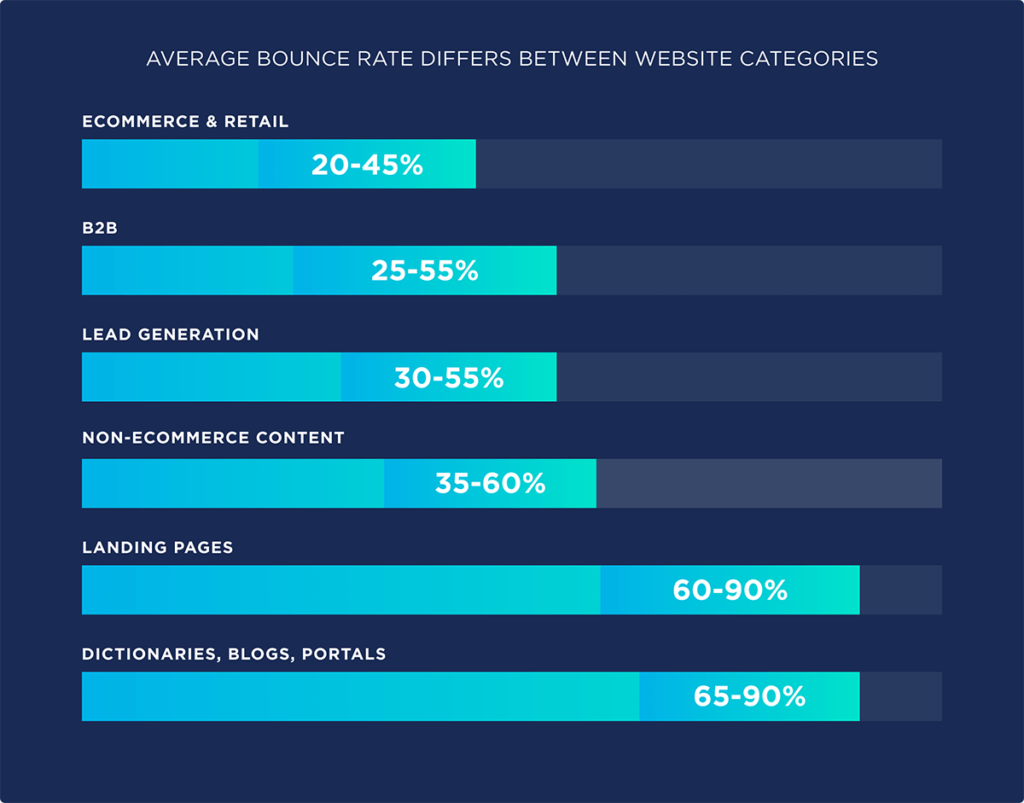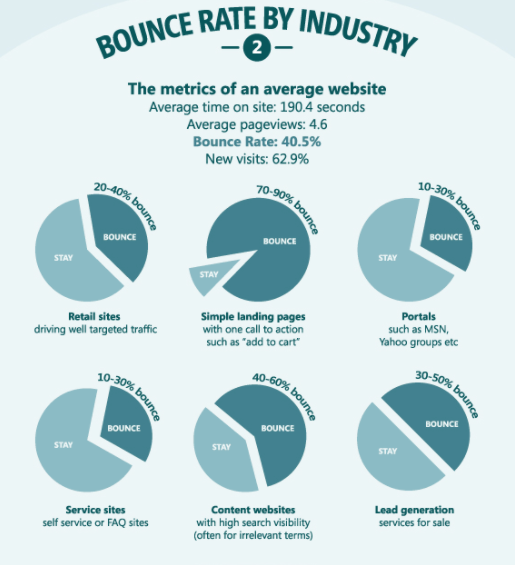
With so many businesses vying for internet visibility, engagement is always the best way to go. But, what if you have a large number of visitors who jump off your website without engaging with your content? A sound strategy is a great way to make the most of the traffic you’re getting online and also reduce bounce rates on your website.
Defining Bounce Rate
A bounce rate is the percentage of visitors that leave a web page without taking action, such as clicking on a link, filling out a form, or making a purchase.

Understanding your bounce rate is significant for three reasons:
- Someone who leaves your site without converting is a bouncer. You may increase website conversions by preventing a visitor from bouncing.
- The bounce rate is a Google ranking element too. This means, a reduced bounce rate can lead to a higher ranking on search engine results pages (SERP).
- A high bounce rate indicates that your website (or individual pages on your website) has content, user experience, page layout, or ad copy concerns.
How Does Bounce Rate Impact Your Page?
Let’s look at a basic example to help you grasp what a bounce rate means for your page. Imagine having a physical store on a popular street. Every day, a large number of individuals walk past your front door. Some of them are interested in the items from the outside. And some of them are obliged to enter. Something, though, does not feel right. Many of these guests come to a complete halt immediately outside the doors, look around, make a strange expression, and then leave.

That is the equivalent of your bounce rate. This metric displays the percentage of total visitors who leave your site without visiting any additional pages or leave right after entering. In that sense, it demonstrates how many prospects are interested enough in your brand to want to learn more about it, but not to the point of communicating with you or purchasing anything from you. However, in order to increase website conversions, it is imperative to reduce bounce rates.
How to Reduce Bounce Rates on Your Website
So, we won’t claim to be able to handle all of your content-related issues at once. However, we do have some pieces of modest advice on how to decrease the bounce rate on your website by optimizing your content.
According to Merriam-Webster, writers have used paragraphs since 1764. That’s a lot of data organized using paragraphs. Most readers nowadays consume your material via a screen— often a tiny one—making it even more important that there be enough visual relief in the form of white space. And this can be achieved by making your content simple to read.
Here are seven tips to take advantage of blank space.
1. Make your content scannable
Rather than reading, most internet users skim. If your writing is difficult to read or comprehend, they’ll move on. Your content will appeal to people the most if the information is broken up into short paragraphs, and separated by subheadings and bullet points. This makes the information easily skimmable.

Another word to keep the reader hooked to the page is by using blurbs, and highlighting important sections with italics or bold. Remember, the purpose of your content is to educate your readers, not intimidate them.
3. Cut to the chase
Each paragraph should have no more than four sentences. Because people’s attention spans are shorter online, your paragraphs should be read in less than eight seconds. Therefore, it is crucial that you convey the information quickly, lest the reader loses interest.
4. Incite curiosity
A sure-shot way to keep your users engaged is to get them curious. Be it an offer or an interesting ending to a story, make sure you keep them wanting to read further.
You can use many brief paragraphs to persuade your readers to keep reading to discover what happens next, just as in movies with cliffhangers. Of course, this works only if each new paragraph adds something fresh to the mix.
5. Provide more “meat”
Short paragraphs force you to keep your writing focused and sharp. This means, your content will be more meaningful, and there will be no scope for fluff. When you offer value to your readers, you give them a chance to trust you. This means they might spend longer periods on your website, consuming your content, which will decrease bounce rates.
6. Incorporate visuals
With the careful placement of photographs, animated GIFs, videos, and more, you can make the web page more visually appealing. Incorporating visual content in your content creation process can help increase website conversions by way of heightened engagement. Visual content is increasingly becoming the most preferred means to distribute information.
7. Use white space effectively

What may be a fully coherent paragraph on paper may become a frightening wall of text on a mobile device. This can be aided by using blank (white) space. When learning how to reduce the bounce rate on your website, consider adding ample white space. This will encourage users to stay on your site for longer (due to a positive user experience), and they will be more likely to interact with your brand.
That’s a wrap on the tips to reduce bounce rates and boost conversion. Even if you succeed in halving your bounce rate, you run the danger of growing it again if you don’t have high-quality content. To avoid this, create a solid content strategy and make sure you stick to it.
Overall, don’t give up, and stay focused. Continue providing your readers with value. If you can achieve that, your visitors will be more likely to stay on your site once they’ve arrived. They’ll gladly tell their friends and family about you, boosting your search traffic as well as lead generation efforts.
FAQs
Low-quality content and poor user experience usually contribute to a high bounce rate.
1. Make the page’s structure apparent
2. Increase the page’s loading time
3. Include high-quality links
4. Provide clear, actionable next steps
5. Include stuff that is both relevant and useful
The percentage of visitors that land on a page and then leave is the bounce rate.
The Exit Rate is the percentage of visitors who exit a specific page (even if they didn’t arrive there initially).
Latest Blogs
Learn how to rank on AI search engines like ChatGPT, Perplexity, and Gemini by optimizing your content for authority, structure, and relevance. Stay ahead in AI-driven search with this strategic guide.
Explore the best healthcare SEO services for your medical practice. Improve online visibility and effectively reach more patients in need of your services.
Discover top social media agencies specializing in banking solutions, enhancing financial services and driving engagement.
Get your hands on the latest news!
Similar Posts

Artificial Intelligence
5 mins read
Top AI Blog Writing Tools for Website Monetization

Blogging
10 mins read
How to Start a Successful Food Blog in 2022

Blogging
4 mins read